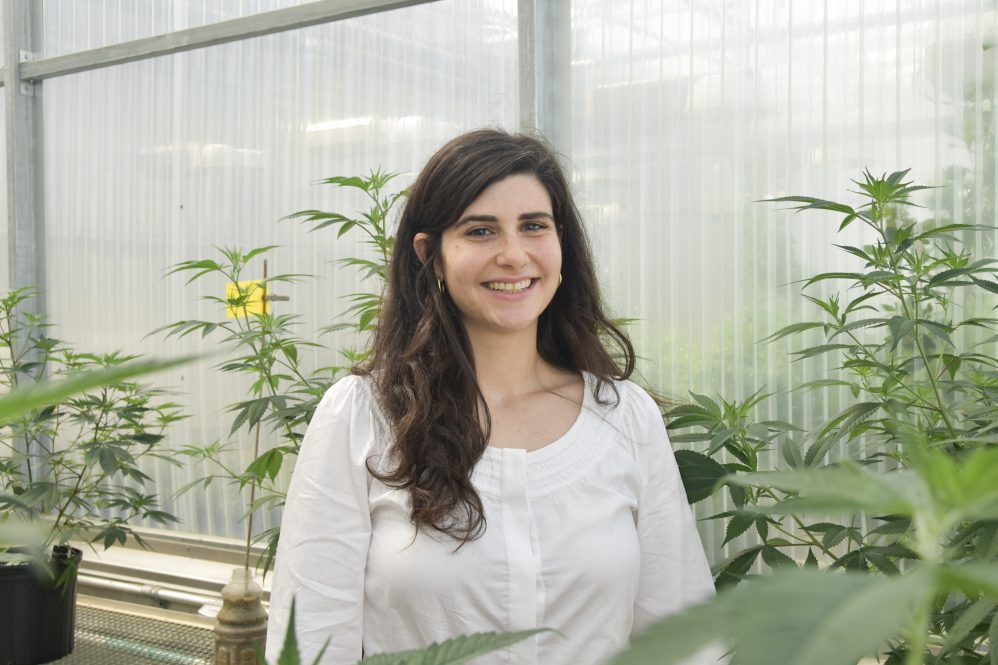Cannabis has become an important part of Connecticut’s economy. With the recent legalization of adult recreational marijuana use, it is only expected to continue growing.
This means it’s important to make sure cannabis plants themselves are also, literally, growing, as well as they can.
Ph.D. candidate Cora S. McGehee and associate professor of horticulture Rosa E. Raudales from the College of Agriculture, Health and Natural Resources published a study in Frontiers in Agronomy documenting the presence of pathogens infecting cannabis plants in Connecticut. This was the first paper that showed these pathogens are present in Connecticut’s cannabis growing facilities.
Plants of all kinds, including cannabis, suffer from infections by a variety of pathogens. So, McGehee and Raudales stumbled into this study by accident. McGehee’s research focuses on plant-microbe interactions in relation to root diseases caused by pathogenic Pythium species in hydroponic lettuce. But her training and Raudales’ expertise in plant pathology put them in a unique position to address similar concerns in a new, high potential crop.
“It’s unavoidable with all the cannabis production around us,” McGehee says.
They were called in on a site visit to assess overall plant health on some cannabis plants in a Connecticut facility. However, during their visit the researchers quickly realized some of the plants were symptomatic of root rot, a disease that causes yellowing, wilting, and reduced growth.
From there, the researchers’ curiosity took over as they tried to get to the bottom of this disorder infecting these plants.
The researchers took soilless substrate samples from coconut coir and rockwool the plants were growing in and performed a series of analyses and experiments. They took samples from the seedling stage as well as mature plants.
First, they looked at the morphological characteristics of the organisms obtained from the soilless substrates. By looking at the size and shape of the sexual and asexual structures under a microscope, the researchers were able to identify what kind of organisms they were looking at.
From there, they isolated DNA from the organisms, amplified genes specific to the organisms, and sent the amplified products to Yale University and Eurofins Genomics LLC laboratories for sequencing which allowed McGehee and Raudales to match their organisms sequences against a national database containing other researchers’ sequences to confirm their identifications.
The researchers identified one isolate of Fusarium oxysporum, three isolates of Globisporangium irregulare and 21 isolates of Pythium myriotylum. Aside from being the most abundant pathogenic species in the samples, Pythium myriotylum isolates were also the most virulent, or harmful, pathogens.
“Once infected, it’s very difficult to revive the plant and use it for profit,” McGehee says. “It’s pretty much a goner.”
The pair then conducted pathogenicity assays with hemp in the laboratory and greenhouse. They set up hundreds of hemp plants in UConn’s Plant Science Research greenhouse and intentionally infected them with the pathogens.
After monitoring these plants carefully, checking daily for symptoms the researchers confirmed all the species and isolates they tested were pathogenic to cannabis plants.
Identifying pathogens of concern provides cannabis growers with important information. By knowing which pathogens “like” cannabis plants, growers can adopt more effective prevention strategies that specifically target these pathogens.
For instance, Pythium species thrive in wet environments. This means growers should be sure to avoid overwatering their crops.
These pathogens also spread easily, meaning growers need to remove infected plants and debris as soon as possible to prevent the pathogen from infecting other crops in production.
The study also found the pathogens were sensitive to mefenoxam, the active ingredient in chemical fungicides used to suppress Pythium. However, this chemical is not labeled for use on cannabis crops.
Growers can employ other strategies such as monitoring water use, pH, and soluble salt levels as well as cleaning, sanitizing, and using biological fungicides to mitigate the impact of these pathogens.
“It’s important for growers to start matching these diseases with the pathogens that cause them,” McGehee says. “I think that will help management strategies and prevent disease outbreaks in their facilities.”
Learn more about CAHNR’s cannabis programs. Follow UConn CAHNR on social media



